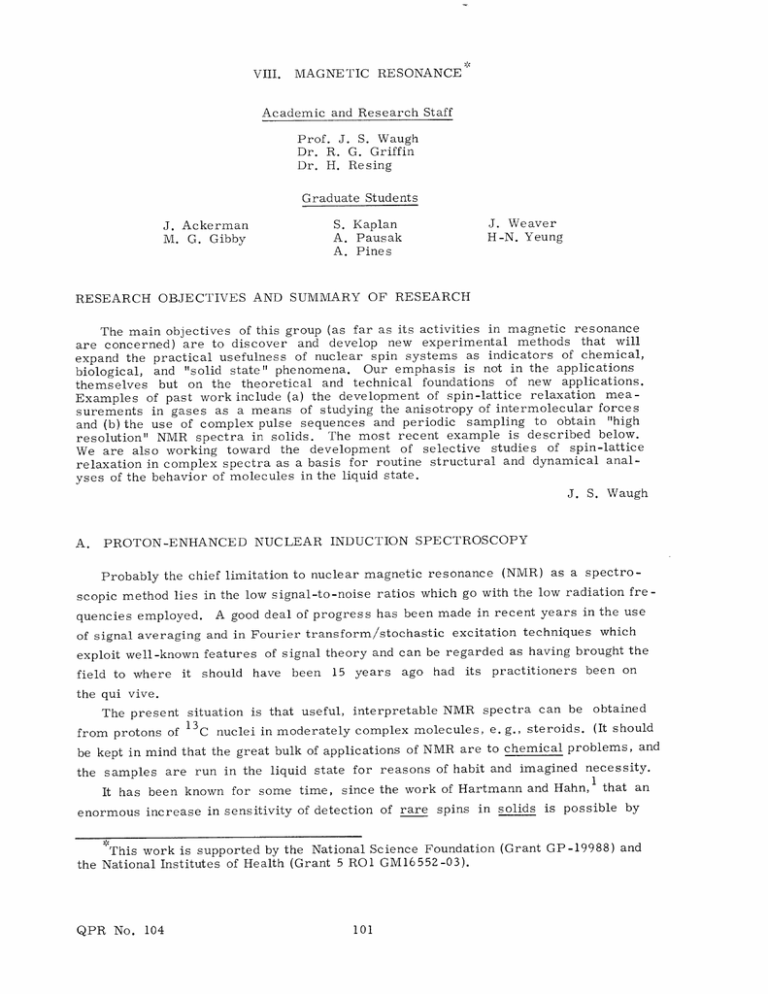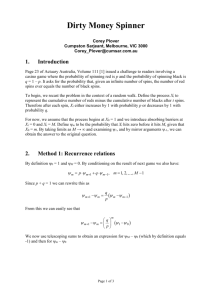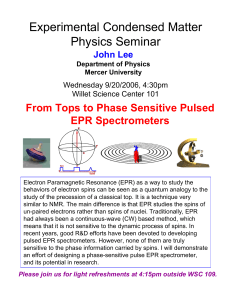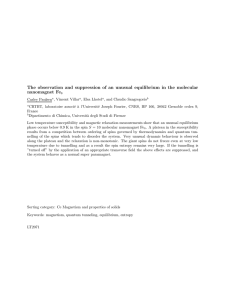Academic and Research Staff Graduate Students
advertisement

VIII. MAGNETIC RESONANCE Academic and Research Staff Prof. J. S. Waugh Dr. R. G. Griffin Dr. H. Resing Graduate Students J. Ackerman M. G. Gibby S. Kaplan A. Pausak A. Pines J. Weaver H-N. Yeung RESEARCH OBJECTIVES AND SUMMARY OF RESEARCH The main objectives of this group (as far as its activities in magnetic resonance are concerned) are to discover and develop new experimental methods that will expand the practical usefulness of nuclear spin systems as indicators of chemical, biological, and "solid state" phenomena. Our emphasis is not in the applications themselves but on the theoretical and technical foundations of new applications. Examples of past work include (a) the development of spin-lattice relaxation measurements in gases as a means of studying the anisotropy of intermolecular forces and (b) the use of complex pulse sequences and periodic sampling to obtain "high resolution" NMR spectra in solids. The most recent example is described below. We are also working toward the development of selective studies of spin-lattice relaxation in complex spectra as a basis for routine structural and dynamical analyses of the behavior of molecules in the liquid state. J. S. Waugh A. PROTON-ENHANCED NUCLEAR INDUCTION SPECTROSCOPY Probably the chief limitation to nuclear magnetic resonance (NMR) as a spectroscopic method lies in the low signal-to-noise ratios which go with the low radiation frequencies employed. A good deal of progress has been made in recent years in the use of signal averaging and in Fourier transform/stochastic excitation techniques which exploit well-known features of signal theory and can be regarded as having brought the field to where it should have been 15 years ago had its practitioners been on the qui vive. The present situation is that useful, interpretable NMR spectra can be obtained from protons of 13C nuclei in moderately complex molecules, e. g., steroids. (It should be kept in mind that the great bulk of applications of NMR are to chemical problems, and the samples are run in the liquid state for reasons of habit and imagined necessity. 1 It has been known for some time, since the work of Hartmann and Hahn, that an enormous increase in sensitivity of detection of rare spins in solids is possible by This work is supported by the National Science Foundation (Grant GP-19988) and Institutes of Health (Grant 5 RO1 GM16552-03). National the QPR No. 104 (VIII. MAGNETIC RESONANCE) various double -resonance methods in which the rare spins are detected through the perturbations which they can be induced to exert systematically on abundant spins (say, protons) in the same sample. These are in general low-resolution methods in which the emphasis is on detection rather than on spectral structure of the rare spin system, the low resolution caused in one way or another by the secular dipolar interactions between rare and abundant spin or among the abundant spins themselves. Recently Bleich and Redfield 2 as well as Mansfield and Grannell 3 have demonstrated methods by which this broadening can be reduced or removed without destroying the sensitivity of the double-resonance methods. An important practical difficulty remains, however, because the rare-spin resonance is detected basically by a single measurement of the magnetization of the abundant spins. Roughly speaking, a single experiment determines only a single point on the rare-spin absorption spectrum, signal-to-noise albeit with enormous ratio. Because of the long spin-lattice relaxation times T l characteristic of solids (especially rigid ones), it is not easy to trade some of this sensitivity at one point for information at reduced sensitivity over a wider spectral range. is easy to envision a situation requiring -1000 It points to define the rare-spin spectrum, each requiring that the spin system recover to spin-lattice equilibrium before recording the next point. If T1 is -1 hr this becomes impractical. We have recently demonstrated a procedure which provides, less overall signal-to-noise ratio than the above methods, spectrum in one shot with adequate in principle, but yields the entire rare-spin sensitivity for most purposes. iants, one of which is the following: somewhat It has many var- the abundant spins are polarized to their equilib- rium magnetization in a strong (but not necessarily homogeneous) field for as long as required. The sample is then placed in a homogeneous field, and the abundant spins placed in a spin-locked state in a strong resonant rf field. A strong rf field is now applied to the rare spins according to the Hartmann-Hahn prescription,l and the rare spins are quickly polarized to a magnetization I/,YS times their normal equilibrium polarization, yS and -I being the gyromagnetic ratios of the rare and abundant species, respectively. The rare-spin field is now cut off, and the free induction decay of the rare spins is recorded directly. are repeated, The application and removal of the rare-spin rf field repolarizing the rare spins at the expense of the abundant spins, and the full induction decays are coherently added. This procedure can be repeated ~NI/N S times without waiting for spin-lattice relaxation, N I and N S being the populations of the spins in question. The abundant-spin rf field is maintained throughout, providing decoupling of the I-S dipolar interactions which would have broadened the rare-spin The accumulated rare-spin decays are now Fourier -transformed to obtain the desired spectrum. The repeated "cross-polarization" procedure provides an resonance. increase of signal-to-noise ratio of -30 dB in the case of the 13C resonance in a typical organic solid over what would be obtained by conventional observation of the 13C spins. QPR No. 104 102 (VIII. MAGNETIC RESONANCE) Since the long T 1 's are no longer an obstacle in this experiment it is possible to make a virtue of necessity by performing the initial polarization at low temperature. If this is done at 4.2 0 K (a temperature which is automatically available if a superconducting magnet is used in the experiment) a further enormous gain in sensitivity occurs. An a priori calculation based on an ideal apparatus and a field-strength of ~60 kg predicts a total signal-to-noise ratio of >120 dB for the 13C spins in natural abundance in a typical organic solid. isotopic Moreover the use of the cross-polarization method results in a considerably weaker dependence of sensitivity on yS and NS than would be the case in conventional spectroscopy, thus opening the possibility of detecting the spectra of spins which are really rare, either isotopically or chemically. The experiment has been demonstrated in a preliminary way on the natural solid adamantane. A spectrum of resolution ~80 Hz was obtained in -0. 7 s, 13 C13in resolving the two chemically inequivalent C atoms in the molecule. J. References 1. S. R. Hartmann and E. 2. H. Bleich and A. G. 3. P. Mansfield and P. QPR No. 104 L. Hahn, Redfield, J. K. Phys. Rev. 128, Chem. Phys. Grannell, J. Phys. 103 (C), 2042 (1962). (in press). L197 (1971). S. Waugh







